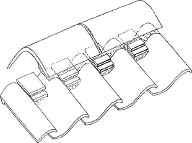Roof Ventilation
To achieve the necessary levels of roof ventilation required by current building standards without disfiguring the external appearance of the roof calls for considerable ingenuity and subtlety. Russell Wright considers the often conflicting requirements of current building standards and traditional detailing.
| Figure 1a. Traditional parapet gutter detail |
Figure 1b. The same detail, modified to conform to Approved Document F2 of The Building Regulations (1991) |
Alec Clifton-Taylor, the celebrated author and broadcaster, was perhaps the first to show how the rich diversity of English building results from the variety of regional building materials and distinctive details. Today, many classes of regional building types, together with their associated repositories of local materials are made obsolete by current building regulations. Problems arise when trying to make unobtrusive additions to listed buildings by replicating existing or traditional features. The thermal performance of an ordinary single-glazed sash window, for example, is insufficient in itself to satisfy Part L of Schedule 1 of the Building Regulations 1991 when placed in correct proportional relationship to a classical facade. Similarly, the traditional method of constructing a parapet gutter - another common classical feature, fails to provide sufficient cross ventilation of roof timbers, to satisfy Approved Document F2 (Figure 1).
Various proprietary devices are available to satisfy AD F2 where eaves ventilation is required. Unfortunately, the majority are intended for use with fascia and soffit boards. These are not common historic features, and are particularly out of place alongside rare forms of eaves construction. On the western edge of the Vale of York, for example, the pantiled belt of the eastern seaboard gives way to the 'upland' roofing materials of the west. Old buildings in this small transitional zone often have an eaves course of fissile sandstone 'flags' beneath an otherwise fully-pantiled roof - a manifestation of a crossover between two distinct roofing traditions. Some ingenuity may therefore be necessary in finding ways of preserving the aesthetic integrity of this detail in new work (Figure 2).
| Figure 2a. 18th century vernacular eaves detail. |
Figure 2b. The same detail, modified to conform to the Building Regulations (1991) |
The effective illegality of a wide range of historic features and methods of construction is of special concern to us. In addition to our general conservation and repair work, much of our practice's work load involves the introduction of new buildings and details within an historic context. To respect the setting we are inevitably concerned with the perpetuation of classical and vernacular architecture in new projects. There is a constant need to find ways of meeting the aesthetic imperatives of such traditions in order to preserve often subtle nuances of detail. At the same time, we must also satisfy current performance standards. This is not too difficult to achieve in the case of a parapet gutter (Figure 1) or where such features are hidden. The main difficulties occur on prominent roof forms, particularly at ridge level. Roof pitches above 15°, where ceiling plaster is attached directly to rafters, are now required to have a ventilation opening right along the ridge-line equivalent to a continuous 5mm gap. (Approved Document F2: 2.1 and 2.5). In historical terms, this opening is a visual contradiction and manufacturers have devised various ways of incorporating ventilation grilles in ridge tiles . But, for our purposes at least, these are not entirely satisfactory. Instead, we prefer to ventilate the ridge of a pantiled roof, for example, by adapting a well-known vernacular detail (Figure 3).
 Figure 3 |
It is tempting to imagine, therefore, that closer contacts between trade associations and conservation practices, perhaps under the auspices of the Building Centre or the Association of Conservation Officers, would result in a range of new products geared more specifically to the conservation market. In reality, our experience is that variety of historic detail is so wide that the production of new standardised components would satisfy relatively few conditions. On the other hand, there is definite scope for refinements or adjustments to existing products to make their application more widely suited to conservation work. In some cases this would merely involve a change in colour (brown or dark-coloured plastic eaves ventilation grilles for example would be less obtrusive than the universal white ones currently available). In other cases we find that the best solutions are often achieved by helpful dialogue between Building Control Officers where acceptable resolutions may be achieved by satisfying the spirit of intent of a particular provision, albeit in unusual, even unorthodox, but nevertheless legal ways.
Compromise is inevitable, and we have yet to come across historic methods of construction or detail where, by a little thought, resolutions of this type cannot be found. This process often involves a degree of improvisation. There are also innumerable instances in our work where simple devices for reconciling the qualities of historic architecture with current standards suggest themselves, but for which no product is available. Why, for example, have brick or tile manufacturers not produced a clay ventilating slip tile? It would be simple to make, preferably with an integral insect grille.
Reconciling the demands of the Building Regulations to traditional architectural forms is, in reality, part of a wider debate about the disfiguring impact of technology. A satellite dish on a mediaeval timber-framed house in Essex, or a uPVC electricity meter box on a Bath stone cottage in Somerset debases historical values just as effectively. What is perhaps most lacking is a wider consensus that such installations are indeed undesirable and that alternatives must be found.
Recommended
Reading
Alec Clifton Taylor,
The Pattern of English Building. Batsford 1962.
Cassells' Building Construction
(1913), page 379.



